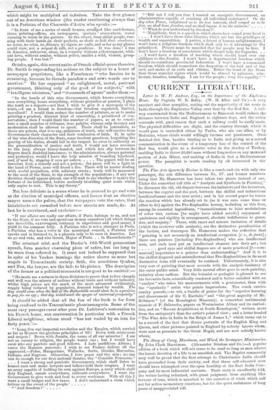The Fine Arts Quarterly Review is like a coach-and-six with
only one passenger, the sole difference between No. IV. and former numbers being that Mr. Hamerton has hero taken two places instead of ono. Under the somewhat tall title of "Analysis and Synthesis in Painting," he discusses the old, old dispute between the imitators and the inventors, between the copyist and the poet, between the skilful and industrious handicraftsman and the true artist; and in his second paper he traces the reaction which has already set in (as it was sure some time or other to do) against the Pre-Raphaelite heresy, including as this does, among its essential ingredients, "insensitiveness to faint modulations of sober tint, curious [he might have added servile] enjoyment of quaintness and rigidity in arrangement, absolute indifference to grace, size, and majesty." These, with exact and minute imitation of details (which the reviewer calla analysis), are the distinctive peculiarities of the faction, and thereupon Mr. Hamerton makes the reflection that "painting is not necessarily an intellectual occupation [i. e., de facto] ; there are painters [including Pre-Raphaelites] who are intellectual men, and such men put an intellectual element into their art ; but
good eyes and skilful fingers are of more practical [?—com- mercial] importance to a painter than understanding." And it is to the skilful-fingered and unintellectual that Pre-Raphaelitism in its most distinctive form will eventually be confined. Unfortunately, it is this very sort of painting that most accords with the analytic tendency of the outer public mind. Very little mental effort goes to such painting, industry alone suffices. But the botanist or geologist is pleased to see his favourite facts scientifically rendered and is better satisfied with an " analyst " who takes his measurements with a goniomoter, than with the " synthetic " artist who paints impressions. The coach carries sundry parcels,—to wit, a bundle of praise for the "superior learning and discernment of Sir 0. Eastlake" and "the great sagacity of Mr. Robinson" (of the Kensington Museum); a somewhat sentimental memoir of P. Delaroche, papers on Westminster Abbey and its curiosi- ties, and on "Recent Acquisitions at South Kensington," written more from the antiquary's than the artist's point of view ; and a letter headed "The Fine Arts in India in the Reign of James I.," which turns out to be a record of the fact that divers portraits of the English King and Queen, and other pictures painted in England by nobody knows wboin, were sent as presents to the Great Mogul, and are now nob'ody knows where.






























 Previous page
Previous page